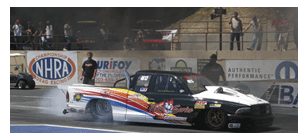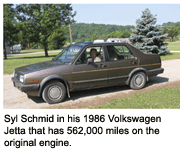Drag Truck Sets New Record
 The Dr. Performance Nitro Series Dodge Dakota drag truck set new Diesel Hot Rod Association (DHRA) Pro Diesel class records in July during the 2007 ATS Diesels on the Mountain/Truck Fest: 8.48 seconds at 164.23 mph. This elapsed time and top speed, set at Denver’s Bandimere Speedway, are both records. DHRA rules require a “back-up” run within 10% for a record to be official: driver Charlie Stewart solidified the 8.48 pass with an 8.312-second pass.
The Dr. Performance Nitro Series Dodge Dakota drag truck set new Diesel Hot Rod Association (DHRA) Pro Diesel class records in July during the 2007 ATS Diesels on the Mountain/Truck Fest: 8.48 seconds at 164.23 mph. This elapsed time and top speed, set at Denver’s Bandimere Speedway, are both records. DHRA rules require a “back-up” run within 10% for a record to be official: driver Charlie Stewart solidified the 8.48 pass with an 8.312-second pass.
“Unfortunately, we stuck a piston on the faster pass and weren’t able to back up that time,” Stewart said. “We have about 100 passes on the engine, and we’re amazed that it’s lasted this long without a rebuild.” Team owner Kenny Laughlin added, “Our goal for this season is to get an official time in the sevens, and we’re right there if you take into account Bandimere’s elevation [5,800 feet above sea level].”
Previously known as the “Predator,” Dr. Performance’s renamed “Nitro Series” 5.9L Cummins-powered Dodge Dakota has run a best “fluke” time (yet to be backed up by another time within 10% in the same year) of 7.82 seconds at the 2007 DHRA Indiana Diesel Nationals.
The Nitro truck’s chassis was built by Jerry Bickel Race Cars. Now in its third season with this truck, the Dr. Performance team consistently posts faster times than the diesel-powered dragsters. (Dr. Performance will unveil its own diesel dragster and a second, shorter-wheelbase Pro Street diesel truck at the 2007 SEMA Show in Las Vegas.) Power begins with a 12-valve Cummins 5.9L engine. “They’re readily available and are a little lighter than the 24-valve blocks,” Stewart said. The engine was built in-house with a combination of production and prototype parts. “Tricks” include friction and ceramics coatings on internal and exhaust components by Polydyne (Houston, TX). Also, Dr. Performance modified the P-pump and ported the heads for superior flow. Proprietary fuel injectors developed with Industrial Injection and a custom camshaft grind to a Bullet billet blank should be available to the public soon. Dr. Performance also plans to offer high-performance Cummins crate motors in the future.
For more information, contact Dr. Performance, 2217 Old Dennis Rd., Weatherford, TX 76087, 877-338-7373, www.drperformance.com.
Volkswagen Diesel Heritage Search Finds Highest Mileage Diesel In Ohio
Auburn Hills, MI — Volkswagen of America, Inc. announced that, as part of its Diesel Heritage Search, it has located the highest mileage Volkswagen diesel vehicle in the United States, a 1986 Jetta Turbo Diesel owned by Syl Schmid of Blue Rock, OH, with more than 562,000 miles. The Jetta’s mileage was recently verified by Volkswagen of America, Inc. and Byers Imports, a Columbus, OH-based Volkswagen dealer. Fuel and mileage records presented by Schmid show the Jetta frequently delivered more than 50 miles per gallon.  “Mr. Schmid has a story that is like so many of our diesel owners; he loves the longevity of the engine and fuel economy that his diesel Volkswagen has delivered these last 20 years,” said Steve Keyes, Volkswagen public relations director. “Throughout all of entries that we received for our Diesel Heritage Search, we found many VW owners who were passionate about their cars and the economic benefits of the diesel engine.”
“Mr. Schmid has a story that is like so many of our diesel owners; he loves the longevity of the engine and fuel economy that his diesel Volkswagen has delivered these last 20 years,” said Steve Keyes, Volkswagen public relations director. “Throughout all of entries that we received for our Diesel Heritage Search, we found many VW owners who were passionate about their cars and the economic benefits of the diesel engine.”
Schmid originally leased the Jetta for three years and decided to purchase the vehicle at the end of that period. After 20 years, and over a half million miles, he is especially proud of the original drivetrain and muffler. In recognition of owning the highest mileage Volkswagen diesel in the U.S., Volkswagen has provided Schmid with a Touareg V10 TDI to drive for six months.
Volkswagen announced their Diesel Heritage Search in March 2007 and received more than 200 entries for the highest mileage and oldest operating U.S. diesel Volkswagen vehicles.
Volkswagen recently recognized a 1977 Rabbit owned by Clint Wilson of Tehachapi, CA, as the oldest diesel Volkswagen.
Volkswagen has sold more than 815,000 diesel vehicles since the introduction of the 1977 Rabbit, the first U.S. Volkswagen diesel. In addition to the currently available diesel Touareg V10 TDI, Volkswagen has previously announced that the 2009 Jetta and Jetta SportWagen, which will be available late first quarter 2008, will feature a Clean Diesel TDI engine option.
BLUETECH Breakup
Wolfsburg, Germany — Automobilwoche magazine in late August reported that Volkswagen and Audi have ended plans to market DPF-equipped low emissions diesel cars in North America under the BLUETEC name they were to share with DaimlerChrysler.
On the eve of the Los Angeles Motor Show in November 2006, DaimlerChrysler, Audi and Volkswagen announced that they intended to establish the BLUETEC brand name as the designation for particularly clean, highly fuel-efficient passenger cars and SUVs with diesel engines. Under the shared concept of BLUETEC, each of the manufacturers involved were to work on their own technical systems for meeting the world’s most stringent emission regulations.
However, industry sources now say that VW and Audi group brands plan to use their own TDI label instead of the BLUETEC designs.
The name BLUETEC covers diesel engines with exhaust emission treatment systems which meet even the strictest emission regulations on the U.S. market. The systems employed by BLUETEC serve in particular to reduce nitrogen oxides (NOx) — the only constituent part of the exhaust gases which, due to the design of the diesel, inherently lies above the value for gasoline engines.
Mercedes-Benz first launched its BLUETEC initiative for passenger cars in the U.S. as the E 320 CDI (see photo above) in October 2006 — the world’s only passenger car to be fitted with this technology.
Mercedes-Benz said it plans to offer another three more V6 BLUETEC models in the U.S. from the GL, M and R-Class ranges later this year as 2008 model-year vehicles.













